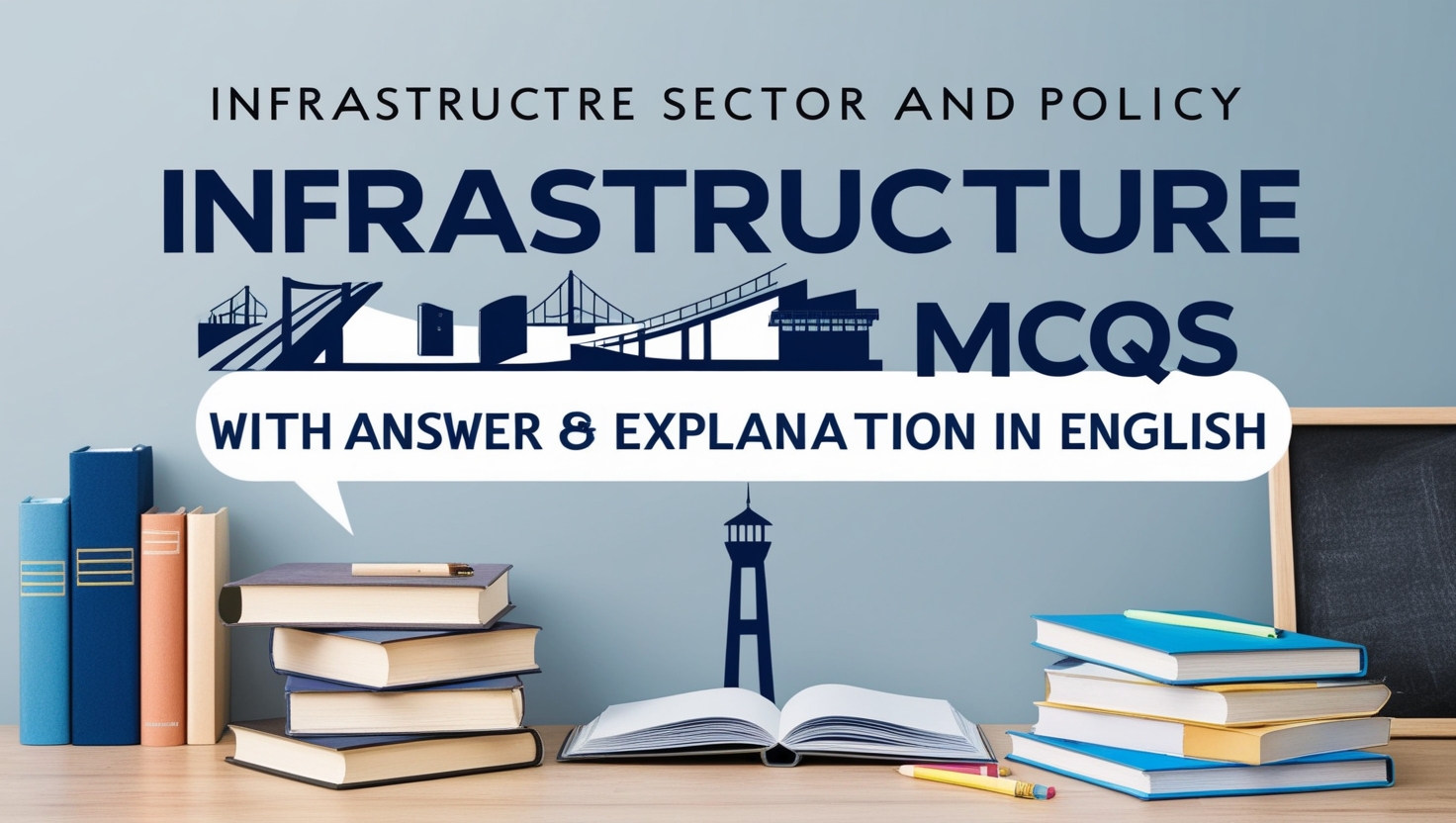
The Infrastructure Sector and Policy GK MCQs With Answer & Explanation in English provides a comprehensive guide to key concepts, developments, and policies shaping the infrastructure landscape. This article is ideal for competitive exam aspirants, students, and professionals seeking to enhance their understanding of infrastructure-related topics.
With detailed answers and explanations, it ensures clarity and a deeper grasp of critical aspects like government initiatives, industry challenges, and policy frameworks. Dive into this resource to strengthen your general knowledge and boost your exam readiness!
1. Government owned infrastructure projects are known as:
- Social Infrastructure
- Public Infrastructure
- Institutional Infrastructure
- Basic Infrastructure
Show Answer
Answer: Public Infrastructure
Public infrastructure refers to government-owned infrastructure projects designed to improve people’s lives and enhance public services. Examples of public infrastructure include roads, hospitals, and other essential facilities, and these projects are typically undertaken with the goal of promoting societal welfare and development.
2. The Central Public Works Department is under the control of which ministry?
- Ministry of Rural Development
- Ministry of Road Transport and Highways
- Ministry of Housing and Urban Affairs
- Ministry of Shipping
Show Answer
Answer: Ministry of Housing and Urban Affairs
The Central Public Works Department (CPWD) operates under the jurisdiction of the Department of Housing and Urban Affairs. CPWD plays a significant role in managing and executing various infrastructure projects, encompassing areas such as roads, flyovers, stadiums, border roads, and more.
3. “The India Infrastructure Report” by Dr. Rakesh Mohan Committee was released in the year?
- 1999
- 1998
- 1997
- 1996
Show Answer
Answer: 1996
In 1996, the Dr. Rakesh Mohan Committee released “The India Infrastructure Report.” According to this report, infrastructure in India was categorized into several critical sectors, including electricity, gas, roads, railways, ports, airways, and industrial parks. These sectors were identified as vital for the nation’s economic growth and development.
4. Investments made by Sovereign Wealth Funds in infrastructure projects can avail tax exemption up to:
- 100%
- 90%
- 65%
- 51%
Show Answer
Answer: 100%
Sovereign Wealth Funds are government-owned investment funds that allocate resources into various financial and real assets. In the Union Budget, SWFs investing in infrastructure projects can enjoy a 100% tax exemption. This exemption is designed to incentivize investments in critical infrastructure ventures.
5. What do we call an infrastructure project that is developed on a completely empty site?
- Brownfield Project
- Bluefield Project
- Greenfield Project
- Yellowfield Project
Show Answer
Answer: Greenfield Project
A Greenfield project refers to the development of a new infrastructure project on vacant or undeveloped land. An example of a Greenfield project in India is the Pakyong Airport in Sikkim, which was constructed on previously unused land, representing a significant addition to the nation’s infrastructure.
6. As per section 801A of the Income Tax Act 1961, business involved in infrastructure projects can claim 100% profits for how many years?
- 15
- 10
- 5
- 7
Show Answer
Answer: 10
Under Section 80-IA of the Income Tax Act, 1961, infrastructure companies can avail of tax holidays for the first ten years. This provision encourages companies to invest in infrastructure development and enjoy tax benefits.
7. What does O stand for in BOT?
- Overhead
- Operate
- Organize
- Official
Show Answer
Answer: Operate
The BOT model, which stands for Build-Operate-Transfer, involves private sector participation in infrastructure projects. In this approach, private entities take responsibility for building and operating projects for a specific period under concessional terms. After this period, control of the project is transferred back to the government.
8. According to the data released by the RBI, how much capital has been mobilized through masala bonds in August 2020?
- Rs. 495 crores
- Rs. 525 crores
- Rs. 501 crores
- Rs. 522 crores
Show Answer
Answer: Rs. 501 crores
Masala bonds are Indian rupee-denominated bonds traded on foreign stock exchanges. They are issued to raise capital for infrastructure projects and other purposes. As of August 2020, eight companies had issued masala bonds, collectively raising capital of Rs 501 crores.
9. Which of the following does not come under social infrastructure?
- Healthcare
- Education
- Housing
- Roads
Show Answer
Answer: Roads
Social infrastructure encompasses services aimed at improving people’s quality of life. These services, such as healthcare, education, and housing, indirectly contribute to economic growth. In contrast, roads are categorized as economic infrastructure, as they facilitate commerce and trade.
10. India is a member of the International Telecommunication Union from which year?
- 1867
- 1869
- 1900
- 1901
Show Answer
Answer: 1869
India has been a member of the International Telecommunication Union (ITU) since 1869. ITU, a United Nations agency, is responsible for establishing international standards in the telecommunications and information and communication technology sectors. Its headquarters are located in Geneva, Switzerland.







